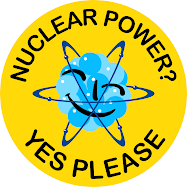For those of us concerned about the environment, irrespective of where we stand on the issue of nuclear energy, one thing is clear, and is agreed upon by anti-nuclear energy activists and nuclear energy proponents alike, and that is that the use of coal combustion for energy generation is not only one of the single biggest contributors to anthropogenic greenhouse gas emissions, but is also a major source of environmental pollution of other forms, including particulates, heavy metals, and organic pollutants, with very significant impacts on the environment, and on human health.
Governments and environmental groups worldwide are today beginning to realise how unsustainable continued reliance on coal combustion for energy generation is.
With this in mind, one may be quite dismayed to hear that the Australian Labor Party is, according to an
official media statement, "Committed to Coal".
I'm not trying to make too much of a political statement here, but I really believe that environmental responsibility must take precedence over securing the future economic viability of Australia's coal industry.
As the world grows increasingly concerned over the potential impact of anthropogenic forcing of climate change, the coal industry, worldwide, will suffer an economic downturn, and other systems of energy generation will take its place - Australia must be prepared for this, and can be prepared for this, given we have the capacity to offset the losses in the coal industry though expansion of Uranium and Thorium mining, without the environmental concerns surrounding coal combustion.
A typical "clean" coal-fired power plant, assuming capture and geosequestration of carbon dioxide with 90% efficiency, is responsible for the emission of 300 grams of CO2 equivalent per kilowatt-hour of electrical energy, 30% of the carbon dioxide emissions of conventional coal plants without CCS technology, assuming a typical coal-fired plant to emit 1000g CO2e/kWhe, which is in the same league as a combined-cycle natural gas plant, at around 500 gCO2/kWhe, compared with around 100g CO2e/kWhe for solar photovoltaics, and far less than that again for wind, nuclear, hydro and geothermal energy.
Gambling our future clean energy development on "clean coal", which may or may not ever actually develop to the point where it is competitive, and environmentally equivalent to, nuclear energy and other clean forms of energy generation is an environmentally dubious move, given that nuclear energy, and other clean technologies are more mature, and arguably far less polluting. After all, "clean coal" still produces fly ash and other hazardous wastes which are usually isolated from the environment in a sub-optimal way.
The ALP's talk of a target of 20% "renewable" energy generation is certainly a good idea, an achievable target, and is do-able, as Sweden (26% renewables, 44% nuclear) and Finland (about 23% renewables, 27% nuclear), for example, demonstrate, but it will make essentially no difference when the remaining 80% is coming from coal - the single most dangerous, environmentally destructive way of generating electricity there is - and it's quite clear that that's what the ALP, for whatever motivation, is interested in seeing to. I hope that, in time, they'll come around, and look fairly at the case for nuclear energy.



















